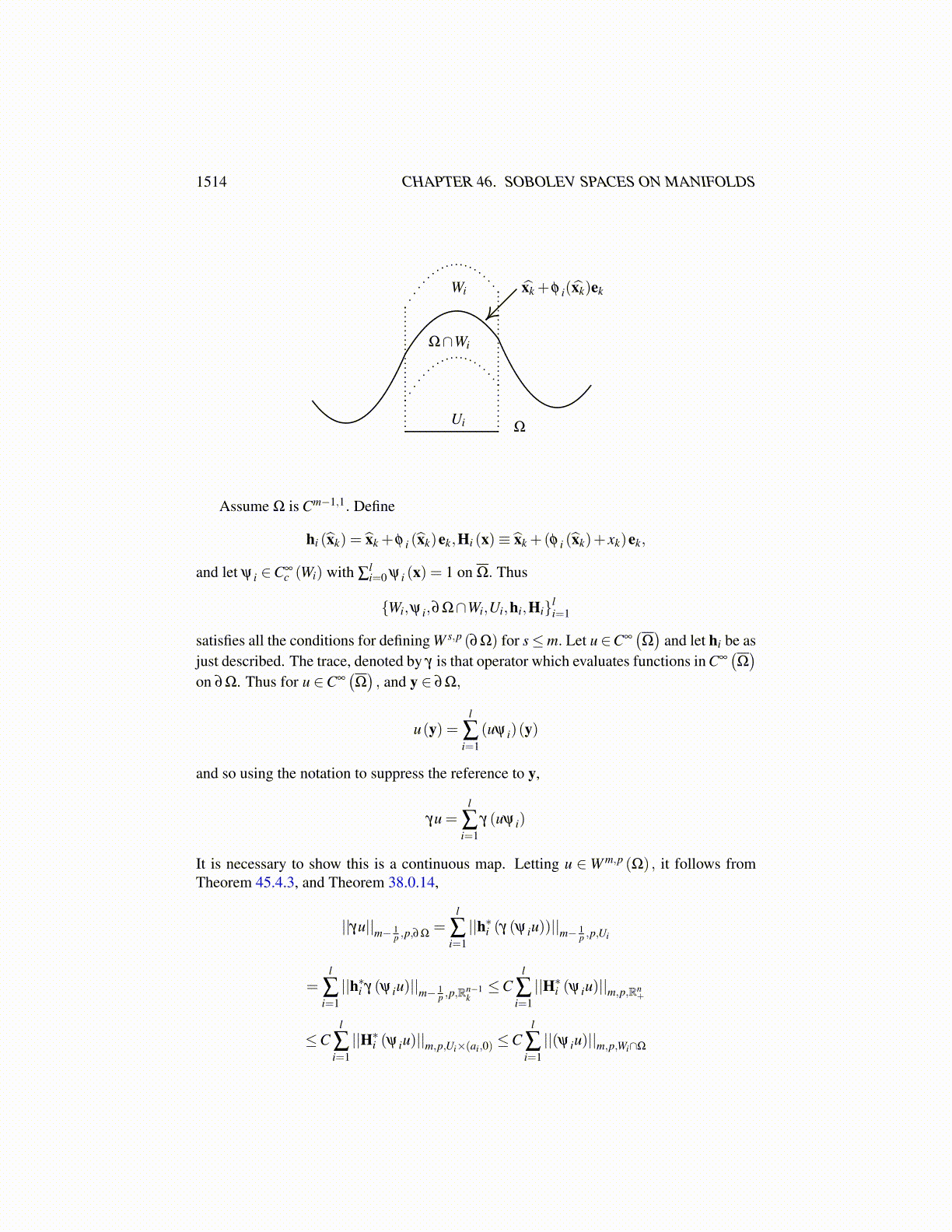
1514 CHAPTER 46. SOBOLEV SPACES ON MANIFOLDS
But also, there exists a subsequence, still denoted by j such that for each i{h∗i (u jψ i)(x)
}∞
j=1
is a Cauchy sequence for a.e. x. Since hi is given to be Lipschitz, it maps sets of measure0 to sets of n dimensional Hausdorff measure zero. Therefore,{
u jψ i (y)}∞
j=1
is a Cauchy sequence for µ a.e. y ∈Wi ∩Γ where µ denotes the n dimensional Hausdorffmeasure. It follows that for µ a.e. y,
{u j (y)
}∞
j=1 is a Cauchy sequence and so it convergesto a function denoted as u(y).
u j (y)→ u(y) µ a.e.
Therefore, wi (x)= h∗i (uψ i)(x) a.e. and this shows h∗i (uψ i)∈W s,p (Ui) . Thus u∈W s,p (Γ)showing completeness. It is clear ||·||s,p,Γ is a norm. Thus L is an isometry of W s,p (Γ) anda closed subspace of ∏
li=1 W s,p (Ui). By Corollary 45.4.2, W s,p (Ui) is reflexive which im-
plies the product is reflexive. Closed subspaces of reflexive spaces are reflexive by Lemma21.2.7 on Page 655 and so W s,p (Γ) is also reflexive. This proves the lemma.
I now show that any two such norms are equivalent.Suppose
{W ′j ,φ j,Γ j,Vj,g j,G j
}r
j=1and {Wi,ψ i,Γi,Ui,hi,Hi}l
i=1 both satisfy the con-
ditions described above. Let ||·||1s,p,Γ denote the norm defined by
||u||1s,p,Γ ≡r
∑j=1
∣∣∣∣∣∣g∗j (uφ j
)∣∣∣∣∣∣s,p,V j
≤r
∑j=1
∣∣∣∣∣∣∣∣∣∣g∗j(
l
∑i=1
uφ jψ i
)∣∣∣∣∣∣∣∣∣∣s,p,V j
≤∑j,i
∣∣∣∣∣∣g∗j (uφ jψ i
)∣∣∣∣∣∣s,p,V j
= ∑j,i
∣∣∣∣∣∣g∗j (uφ jψ i
)∣∣∣∣∣∣s,p,g−1
j
(Wi∩W ′j
) (46.1.2)
Now define a new norm ||u||1,gs,p,Γ by the formula 46.1.2. This norm is determined by{W ′j ∩Wi,ψ iφ j,Γ j ∩Γi,Vj,gi, j,Gi, j
}where gi, j = g j. Thus the identity map
id :(
W s,p (Γ) , ||·||1,gs,p,Γ
)→(
W s,p (Γ) , ||·||1s,p,Γ)
is continuous. It follows the two norms, ||·||1,gs,p,Γ and ||·||1s,p,Γ , are equivalent by the open
mapping theorem. In a similar way, the norms, ||·||2,hs,p,Γ and ||·||2s,p,Γ are equivalent where
||u||2s,p,Γ ≡l
∑j=1||h∗i (uψ i)||s,p,Ui